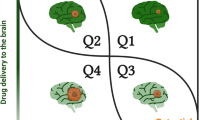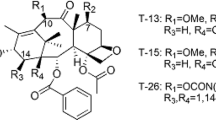Summary
This report describes the physicochemical and pharmacokinetic parameters of seven chlorambucil esters, which were compared with those of chlorambucil. These esters were designed as chlorambucil prodrugs to increase the brain penetration and concentration vs time profile of chlorambucil within the CNS for potential treatment of brain tumors. They include four aliphatic esters from one to eight carbon chains in length (chlorambucil-methyl,-propyl,-hexyl, and-octyl esters) and three aromatic esters, including the phenylmethyl, phenylethyl and prednisolone ester of chlorambucil, prednimustine. The esters were lipophilic and possessed log octanol: water partition coefficients (log P values) that ranged from 4.05 to >8.0. All retained alkylating activity, which was reduced compared with that of chlorambucil. In addition, all were metabolized in vivo in the rat to yield chlorambucil alone. Measurement of the in vitro rate of ester hydrolysis of the compounds to yield chlorambucil in rat plasma demonstrated that short-chain aliphatic and aromatic chlorambucil esters were rapidly broken down to their parent compound. The plasma half-lives of the compounds increased with the increasing length and complexity of their ester chain. This may have been related to an increase in the binding of the long-chain esters to plasma proteins, protecting the ester from nonspecific plasma esterases, and to a reduced affinity of plasma esterases to these esters. Pharmacokinetic analysis of chlorambucilhexyl,-octyl, and-prednisolone esters by HPLC demonstrated that following their intravenous administration in the rat (in doses equivalent to equimolar chlorambucil, 10 mg/kg), they yielded only low concentrations of active compounds in plasma and brain. The brain: plasma ratio of these was low and similar to that of chlorambucil, and no ester demonstrated anticancer activity superior to that obtained after the administration of equimolar chlorambucil (5 mg/kg i. v., days 1–5) against brain-sequestered Walker 256 carcinosarcoma in the rat.
Similar content being viewed by others
References
Anderson J, Christensen L, Krogshlom H (1984) Phase II trial of prednimustine in glioblastoma multiforme. Cancer Treat Rep 68: 795–797
Augustinsson KB (1961) Multiple forms of esterase in vertebrate blood plasma. Ann NY Acad Sci 94: 844–860
Blakelee D, Kennedy JC (1974) Factors affecting the noncovalent binding of chlorambucil to immunoglobulin G. Cancer Res 34: 882
Boyer PD (1971) The enzymes, vol 5. Academic, New York
Carter SK, Bakowski MT, Hellman K (1987) Chemotherapy of cancer, 3rd edn. Wiley Medical, New York
Connors TA (1974) Mechanisms of clinical drug resistance to alkylating agents. Biochem Pharmacol 23 [Suppl 2]: 89–100
Cornbleet M, Leonard R, Smyth J (1984) High-dose agent therapy: a review of clinical experiences. Cancer Drug Deliv 1: 227–238
Dorr R, Fritz W (1980) Cancer chemotherapy handbook. Kimpton, London
Ehrsson H, Eksborg S, Wallin I, Nilsson S (1980) Degradation of chlorambucil in aqueous solution. J Pharm Sci 69: 1091
Ehrsson H, Lonroth U, Wallin I, Ehrnebo M, Nilsson S (1981) Degradation of chlorambucil in aqueous solution: influence of human albumin binding. J Pharm Pharmacol 33: 313–315
Farmer PB, Foster AB, Jarman DR, Newell DR, Oddy DR, Kiburis JM (1979) The metabolism of deuterated analogues of chlorambucil in the rat. Chem Biol Interact 28: 211–220
Friedman HS, Schold SC, Bigner DD (1986) Chemotherapy of subcutaneous and intracerebral human medulloblastoma xenografts in athymic nude mice. Cancer Res 46: 224–228
Godeneche D, Madelmont J, Moreau M, Plagne R, Meyniel G (1980) Comparative physico-chemical properties, biological effects, and disposition in mice of four nitrogen mustards. Cancer Chemother Pharmacol 5: 1–9
Goldie J, Coldman A (1979) A mathematical model for relating the drug sensitivity of tumors to their spontaneous mutation. Cancer Treat Rep 63: 172
Greig NH (1984) Chemotherapy of brain metastases: current status. Cancer Treat Rev 11: 157–180
Greig NH (1987) Optimizing drug delivery to brain tumors. Cancer Treat Rev 14: 1–28
Greig NH (1989) Drug delivery to the brain by blood-brain barrier circumvention and drug modification. In: Neuwelt EA (ed) Implications of the blood-brain barrier and its manipulation, vol 1. Plenum Press, NY, pp 311–367
Greig NH, Rapoport SI (1988) Comparative brain and plasma pharmacokinetics and anticancer activities of chlorambucil and melphalan in the rat. Cancer Chemother Pharmacol 21: 1–8
Greig NH, Momma S, Sweeney DJ, Smith QR, Rapoport SI (1987) Facilitated transport of melphalan at the rat bloodbrain barrier by the large neutral amino acid carrier system. Cancer Res 47: 1571–1576
Greig NH, Sweeney DJ, Rapoport SI (1987) Melphalan concentration dependent plasma protein binding in healthy humans and rats. Eur J Clin Pharmacol 32: 179–185
Hansch C (1969) A quantitative approach to biochemical structure-activity relationships. Acc Chem Res 2: 232–239
Hill B (1972) Studies on the transport and cellular distribution of chlorambucil in the Yoshida ascites sarcoma. Biochem Pharmacol 21: 495–502
Hofstee BHJ (1954) Specificity of esterases: IV. Behavior of horse liver esterase towards a homologous series of n-fatty acid esters. J Biol Chem 207: 219–224
Jenner P, Testa B (1981) Concepts in drug metabolism, vol. 10, part B. Marcel Dekker, New York
Jusko W, Gretch M (1976) Plasma and protein binding of drugs in pharmacokinetics. Drug Metab Rev 5: 43–140
Lee FYF, Coe P, Workman P (1986) Pharmacokinetic basis for the comparative antitumor activity and toxicity of chlorambucil, phenylacetic mustard andB,B-difluorochlorambucil (CB 7103) in mice. Cancer Chemother Pharmacol 17: 21–29
Leo A, Hansch C, Elkins D (1971) Partition coefficients and their uses. Chem Rev 71: 525–616
MacKichan J (1984) Pharmacokinetic consequences of drug displacement from blood and tissue proteins. Clin Pharmacokinet 9: 32–41
Malhotra OP, Philip G (1966) Specificity of goat intestinal esterase. Biochem Z 346: 386–402
Marquardt D (1963) An algorithm for least squares estimation of nonlinear parameters. J Soc Ind Appl Math 11: 431–441
McLean A, Newell D, Baker G (1976) The metabolism of chlorambucil. Biochem Pharmacol 25: 2331
McLean A, Woods RL, Catovsky D, Farmer P (1979) Pharmacokinetics and metabolism of chlorambucil in patients with malignant disese. Cancer Treat Rev [Suppl] 6: 33
Miller R (1966) Simultaneous statistical inference. McGraw-Hill, New York pp 76–81
Nemethy G (1967) Hydrophobe Weschselwirkungen. Angew Chem 79: 260–271
Neuwelt EA (1984) Therapeutic potential for blood-brain barrier modification in malignant brain tumor. Prog Exp Tumor Res 28: 51–66
Newell DR, Shepherd CR, Harrap KR (1981) The pharmacokinetics of prednimustine and chlorambucil in the rat. Cancer Chemother Pharmacol 6: 85–91
Newell DR, Calvert AH, Harrap KR (1983) Studies on the pharmacokinetics of chlorambucil and prenimustine in man. Br J Clin Pharmacol 15: 253–258
Owen WR, Stewart PJ (1979) Kinetics and mechanism of chlorambucil hydrolysis. J Pharm Sci 68: 992–996
Rapoport S (1976) Blood-brain barrier in physiology and medicine. Raven, New York
Robinson PJ, Rapoport SI (1986) Kinetics of protein binding determine rates of uptake of drugs by brain. Am J Physiol 251: R1212-R1220
Roehrig GR, Billman JH, Marcec J, Fritz P, Shea F (1980) Synthesis and antitumor activity of 4-[p-[bis(2-chloroethyl)-amino]phenyl]butyrates. J Pharm Sci 69: 1232–1234
Schabel FM, Johnston TP, McCaler GS, Montgomery JA, Laster WR, Skipper HE (1963) Experimental evaluation of potential anticancer agents: VIII. Effects of certain nitrosoureas on intracerebral L1210 leukemia. Cancer 23: 725–733
Schabel FM, Trader MW, Laster WR, Wheeler GP, Witt MH (1978) Patterns of resistance and therapeutic synergism among alkylating agents. Fundam Cancer Chemother Antibiot Chemother 23: 200–215
Scholtan W (1968) Die hydrophobe Bindung der Pharmaka an human Albumin und Ribonucleinsäure. Arzneim-Forsch 18: 505–517
Sheridan MA, Nines RG, Riblet SM, Finfrock MF, Trigg NJ, Houchens DP (1986) Glioma and medulloblastoma xenografts as models for brain tumor development. Proc Am Assoc Cancer Res 27: 385
Skipper H, Schabel F, Wilcox W (1964) Experimental evaluation of anticancer agents: VII. On the criteria and kinetics associated with “curability” of experimental leukemia. Cancer Chemother Rep 35: 1–111
Stoops JK, Horgan DJ, Runnegar MTC, DeJersey J, Webb EC, Zerner B (1969) Carboxylesterases (EC 3.1.1). Kinetic studies on carboxylesterases. Biochemistry 8: 2026–2033
Walker MD (1977) Treatment of brain tumors. Med Clin North Am 61: 1045–1051
Walker MD, Green SB, Byar DP, Alexander E, Batzdorf U, Brooks WH, Hunt WE, MacCarty CS, Mahaley MS, Mealey J, Owens G, Ransohoff J, Robertson JT, Shapiro WR, Smith KR, Wilson CB, Strike TA (1980) Randomized comparisons of radiotherapy and nitrosoureas for the treatment of malignant glioma after surgery. N Engl J Med 303: 1323–1329
Wilkinson R, Gunnarsson PO, Plym-Forshell G, Renshaw J, Harrap KR (1978) The hydrolysis of prednimustine by enzymes from normal and tumour tissues. Exerpta Med Int Congr Ser 420: 260–273
Author information
Authors and Affiliations
Rights and permissions
About this article
Cite this article
Greig, N.H., Genka, S., Daly, E.M. et al. Physicochemical and pharmacokinetic parameters of seven lipophilic chlorambucil esters designed for brain penetration. Cancer Chemother. Pharmacol. 25, 311–319 (1990). https://doi.org/10.1007/BF00686229
Received:
Accepted:
Issue Date:
DOI: https://doi.org/10.1007/BF00686229




